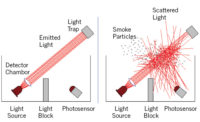In April and June of 2013 three people, a couple and an 11-year-old boy, died at the Best Western Blue Ridge Plaza in Boone, N.C. They all were exposed to deadly levels of carbon monoxide (CO) while staying in the same second-floor room directly above a room that housed the natural-gas heater for the hotel pool. By August 2013 a bill, HB 74, had been signed into law, expanding the state’s current CO law to require CO detection in lodging establishments.
The passage of HB 74 brings the number of states requiring CO detection in commercial occupancies such as hotels, dormitories, apartment buildings or education occupancies to 21. Additionally, the latest versions of the International Building Code (IBC), International Fire Code (IFC) and several National Fire Protection Association (NFPA) codes and standards, including NFPA 72 and NPFA 720, have similar requirements, opening new opportunities for installers in several commercial markets.
“After what happened in North Carolina, we’ve seen an increase in hotels looking at CO detection to protect their customers from carbon monoxide. We’ve also seen an increase in schools looking at the technology as well. Basically, there has been widespread adoption of residential CO, and now that it is expanded into the commercial market, encompassing any place where there are sleeping quarters or fuel-burning appliances, which includes commercial spaces like schools, hotels, senior living facilities, day cares, churches, and more,” says Doug Hoeferle, senior product marketing manager, System Sensor, St. Charles, Ill.
These detectors are not super expensive when you weigh the health and life-safety benefits, reminds Vicki Sword, senior product manager for intrusion brands for Tyco Security Products. “Compared to the emotional and physical loss of life or property, these features come at a small price,” she says.
Legislation has and will continue to drive growth in the use of CO sensors, and there’s a growing awareness of existing standards. “I am seeing that municipalities have slowed or stopped from creating their own language for the installation of CO devices and have adopted NFPA 720, Standard for the Installation of Carbon Monoxide (CO) Detection and Warning Equipment,” says Rodger Reiswig, director, Industry Relations, SimplexGrinnell, Westminster, Mass., a Tyco business.
The expansion of CO awareness in commercial settings is bringing fire and CO detection closer together — all the way into a single combination device in some cases. In commercial settings, material and labor costs can add up very quickly. New combination smoke/CO devices that are just starting to hit the market are helping life safety dealers reduce those costs, while simultaneously offering streamlined aesthetics.
As commercial occupancies involve larger installations, material and labor costs carry a greater impact. One solution gaining momentum in the industry is new combination detectors that place the smoke and CO detector in the same unit.
At ISC West this year, System Sensor launched the Series CO/Smoke detector, which it announced as the first system-connected combination CO and smoke detector for conventional fire alarm systems.
“System Sensor’s device is a detector and a module. It handles 12 detectors, so we’ve seen it received well in residential applications and commercial applications like churches or daycare centers,” System Sensor’s Hoeferle says.
While this unit is ideal for residential and small commercial applications, Gamewell-FCI and Silent Knight are among manufacturers offering a full-scale addressable commercial combination offering for larger settings such as hotels and schools.
“I did lots of projects — high-rise, dormitory and full-system situations — where we were required to add CO, and it used to be quite a difficult situation,” recalls Geoff Szabo, sales engineer, JAM Fire Protection Inc., Monrovia, Calif., a Gamewell-FCI dealer. “We’d have to have individually installed CO detectors, and then we would put a monitoring module on to be able to pick it up. It was cumbersome, expensive, and the actual CO detector itself was nothing to get excited about. These combination units are quite a step forward and a tremendous advantage.”
Separate smoke and CO detectors are being combined into one device for two reasons: aesthetics and cost, according to Loren Schreiber, product marketing manager, Silent Knight by Honeywell, Northford, Conn. “Architects and building owners prefer the improved aesthetics of one device instead of three or four devices taking real estate on the wall,” Schreiber shares. “Secondly, fire alarm dealers save money by eliminating wiring and multiple junction box costs,” he says.
While a standard commercial installation would include a CO detector, smoke detector, separate mini horn for both, separate wiring, and separate junction boxes, the combination device is one device and one junction box.
“We estimate savings of about $200 per installation/room. In a commercial installation like a hotel or dormitory environment that adds up quickly,” says Brian Carlson, director of marketing, Gamewell-FCI by Honeywell, Northford, Conn.
Bringing a CO sensor into the fire alarm also offers the option for multi-detection to lower false fire alarms. “There is more integration of CO as a multi-sensor to reduce nuisance fire alarms as well as detect poisonous gas,” says John Haynes, global director, Simplex Product Management, Tyco Fire Protection Products.
Gamewell-FCI’s Carlson says that by making the CO detector into an advanced multi-criteria detector, it provides better detection against false alarms and nuisance alarms, which is a major selling point.
There are places where a combination unit simply wouldn’t be needed, but in the newest commercial applications such as hotels and schools, these devices will just continue to gain momentum over time, predicts Timothy R. McGee, vice president and chief operations officer, West Fire Systems Inc., Rochester, N.Y.
“We just wrapped up three off-campus fraternity houses with these combination devices. We were working in old, large homes converted into fraternity homes and the idea that we could hang smoke and CO on the same addressable circuit as a pull station was advantageous,” he describes.
Some drawbacks to the new combination devices include the differing end-of-life for the fire and CO sensors, which is a question still to be answered points out Lew Kramer, applications solution designer for Springfield, Mo.-based manufacturer Digital Monitoring Products (DMP). He shared DMP is researching the best way to handle the differing end-of-life for the fire and CO sensors before deciding to combine it into a unit.
System Sensor has chosen to make the CO sensor replaceable within the device — especially since it has a residential/small commercial focus, making the replacement easy. Other companies like Quantum Group Inc., San Diego, chose not to make the CO sensor replaceable. “We were the first to do a replaceable CO sensor, but we moved away from it for a variety of reasons. First, we were able to extend the life of the senor to six years. Secondly, when you have a replaceable sensor — you have to worry about electrical contacts in certain places like factories where there is corrosion. We have chosen to replace the whole alarm and keep everything high functioning,” shares Mark K. Goldstein, Ph.D., founder and CEO of Quantum Group Inc., San Diego.
Generally, smoke alarms for alarm units are required to be replaced every 10 years, and CO alarms are required to be replaced when they reach end of life, although that can vary from manufacturer to manufacturer.
With combination detectors, the NFPA recommends following the installation guidelines for the fire detectors, which have much more stringent requirements. “When you have a combination CO/smoke alarm, or CO-smoke detector you have to follow the rules for smoke detection or smoke alarm,” emphasizes Lee F. Richardson, senior electrical engineer at NFPA, where he is responsible for NFPA 72 and 720.
Szabo anticipates the industry will only see more combination CO/smoke detectors together in the future. “I think it’s just going to be a common thing, and we’ll look back at the previous years and say, ‘Why didn’t we have CO as part of our smoke detectors back then? Can you imagine?’” he predicts.
Combination CO/Fire Detectors Bring Calif. High-Rise Into Compliance
JAM Fire Protection, Monrovia, Calif., is working on bringing a 19-story high-rise up to code in Costa Mesa, Calif. The building includes an assisted senior facility, consisting mostly of studio apartments, which all require CO detection per California legislation.
“The building was built in the ‘60s and was seriously sub-standard as far as fire alarm and CO compliance was concerned,” describes Geoff Szabo, JAM Fire Protection. Szabo worked very closely with the owners of the building and the local fire department in designing the system and having it accepted. “The developers initially went to the city and were going to try to do new sprinklers and the complete fire alarm system down the common corridors only. The fire department threw that out, and the facility had to put one sprinkler head in each unit right above the entrance door. The fire department agreed with and signed off on JAM’s design of putting in complete area detection with combination CO detectors,” he describes.
The simplified upgrade will still cost more than $200,000, but it saved the developer a substantial amount of money. Also, the combination detectors, distributed in the living room/kitchen areas in every living unit (some units have multiple, depending on the size of each to provide adequate coverage) are on sounder bases, saving numerous conduits, boxes, and additional wiring by using one combination CO/fire detector.
JAM Fire Protection will be installing more than 300 of the combination CO/fire detectors.
“Buying two detectors in one, and being able to have it on our fire alarm system is a huge advantage, from a sales standpoint, from a marketing standpoint, and just from a technology standpoint,” Mike Mongillo, project manager, JAM Fire Protection.
It also provides a lot of flexibility for programming and notification.
“There is actual indication to building personnel that there is a problem. They can see it down at the panel too, whereas with a 120-volt detector, it’s just a local unit, and nobody else would know about it,” Szabo shares.
CO Expanding to Schools? New Bill in CA Might Accelerate the Trend
On December 3, 2012, Finch Elementary School in Atlanta, Ga., was evacuated after firefighters discovered a carbon monoxide leak from the school’s furnace. In total, 43 students and 10 adults were taken to the local hospital. The state of Georgia did not require school facilities to have CO detectors, and Finch Elementary School did not have them. Since then, two states, Maryland and Connecticut, have passed legislation requiring carbon monoxide detectors in school facilities.
California has a new bill on the table, Assembly Bill No. 56, which would add it to the list. This bill would require any private or public school building used for educational purposes for kindergarten or any of grades 1 to 12, inclusive, that is built on or after January 1, 2014, and that has a fossil fuel-burning furnace located inside the school building, to have a CO detecting device. In an analysis conducted by the National Fire Protection Association of non-fire carbon monoxide incidents reported for the year 2005, 250 carbon monoxide incidents were reported nationwide in educational facilities. Of these, 150 incidents occurred in school buildings used for preschool, kindergarten, or grades 1 to 12. — Information contributed by Jay Levy, regional manager, Hochiki America Corporation, Buena Park, Calif.







